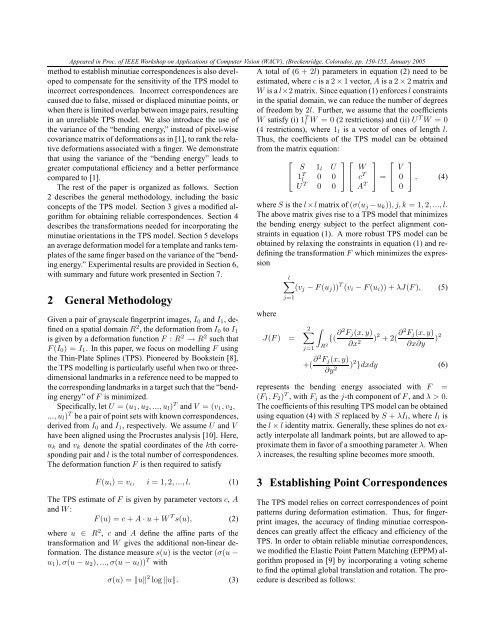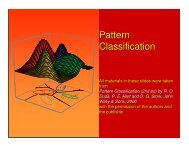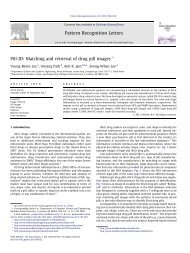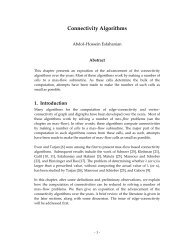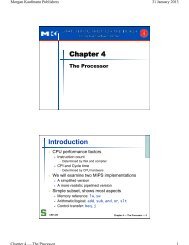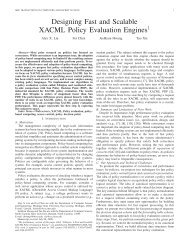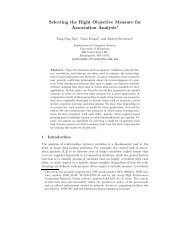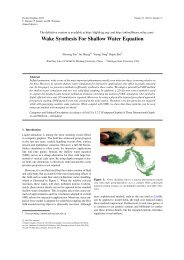Fingerprint Deformation Models Using Minutiae Locations and ...
Fingerprint Deformation Models Using Minutiae Locations and ...
Fingerprint Deformation Models Using Minutiae Locations and ...
Create successful ePaper yourself
Turn your PDF publications into a flip-book with our unique Google optimized e-Paper software.
Appeared in Proc. of IEEE Workshop on Applications of Computer Vision (WACV), (Breckenridge, Colorado), pp. 150-155, January 2005method to establish minutiae correspondences is also developedto compensate for the sensitivity of the TPS model to estimated, where c is a 2 × 1 vector, A is a 2 × 2 matrix <strong>and</strong>A total of (6 + 2l) parameters in equation (2) need to beincorrect correspondences. Incorrect correspondences are W is a l×2 matrix. Since equation (1) enforces l constraintscaused due to false, missed or displaced minutiae points, or in the spatial domain, we can reduce the number of degreeswhen there is limited overlap between image pairs, resulting of freedom by 2l. Further, we assume that the coefficientsin an unreliable TPS model. We also introduce the use of W satisfy (i) 1 T l W = 0 (2 restrictions) <strong>and</strong> (ii) U T W = 0the variance of the “bending energy,” instead of pixel-wise (4 restrictions), where 1 l is a vector of ones of length l.covariance matrix of deformations as in [1], to rank the relativedeformations associated with a finger. We demonstrate from the matrix equation:Thus, the coefficients of the TPS model can be obtainedthat using the variance of the “bending energy” leads to⎡greater computational efficiency <strong>and</strong> a better performancecompared to [1].⎣ S 1 ⎤ ⎡l U1 T l 0 0 ⎦ ⎣ W ⎤ ⎡c T ⎦ = ⎣ V ⎤0 ⎦ , (4)The rest of the paper is organized as follows. SectionU T 0 0 A T 02 describes the general methodology, including the basicconcepts of the TPS model. Section 3 gives a modified algorithmfor obtaining reliable correspondences. Section 4 The above matrix gives rise to a TPS model that minimizeswhere S is the l×l matrix of (σ(u j −u k )), j, k = 1, 2, ..., l.describes the transformations needed for incorporating the the bending energy subject to the perfect alignment constraintsin equation (1). A more robust TPS model can beminutiae orientations in the TPS model. Section 5 developsan average deformation model for a template <strong>and</strong> ranks templatesof the same finger based on the variance of the “benddefiningthe transformation F which minimizes the expres-obtained by relaxing the constraints in equation (1) <strong>and</strong> reingenergy.” Experimental results are provided in Section 6, sionwith summary <strong>and</strong> future work presented in Section 7.l∑(v j − F (u j )) T (v i − F (u i )) + λJ(F ), (5)2 General MethodologyGiven a pair of grayscale fingerprint images, I 0 <strong>and</strong> I 1 , definedon a spatial domain R 2 , the deformation from I 0 to I 1is given by a deformation function F : R 2 → R 2 such thatF (I 0 ) = I 1 . In this paper, we focus on modelling F usingthe Thin-Plate Splines (TPS). Pioneered by Bookstein [8],the TPS modelling is particularly useful when two or threedimensionall<strong>and</strong>marks in a reference need to be mapped tothe corresponding l<strong>and</strong>marks in a target such that the “bendingenergy” of F is minimized.Specifically, let U = (u 1 , u 2 , ..., u l ) T <strong>and</strong> V = (v 1 , v 2 ,..., u l ) T be a pair of point sets with known correspondences,derived from I 0 <strong>and</strong> I 1 , respectively. We assume U <strong>and</strong> Vhave been aligned using the Procrustes analysis [10]. Here,u k <strong>and</strong> v k denote the spatial coordinates of the kth correspondingpair <strong>and</strong> l is the total number of correspondences.The deformation function F is then required to satisfyF (u i ) = v i , i = 1, 2, ..., l. (1)The TPS estimate of F is given by parameter vectors c, A<strong>and</strong> W :F (u) = c + A · u + W T s(u), (2)where u ∈ R 2 , c <strong>and</strong> A define the affine parts of thetransformation <strong>and</strong> W gives the additional non-linear deformation.The distance measure s(u) is the vector (σ(u −u 1 ), σ(u − u 2 ), ..., σ(u − u l )) T withσ(u) = ‖u‖ 2 log ‖u‖. (3)wherej=1J(F ) =2∑∫j=1{( ∂2 F j (x, y)R ∂x 2 ) 2 + 2( ∂2 F j (x, y)∂x∂y2+( ∂2 F j (x, y)∂y 2 ) 2 }dxdy (6)represents the bending energy associated with F =(F 1 , F 2 ) T , with F j as the j-th component of F , <strong>and</strong> λ > 0.The coefficients of this resulting TPS model can be obtainedusing equation (4) with S replaced by S + λI l , where I l isthe l × l identity matrix. Generally, these splines do not exactlyinterpolate all l<strong>and</strong>mark points, but are allowed to approximatethem in favor of a smoothing parameter λ. Whenλ increases, the resulting spline becomes more smooth.3 Establishing Point CorrespondencesThe TPS model relies on correct correspondences of pointpatterns during deformation estimation. Thus, for fingerprintimages, the accuracy of finding minutiae correspondencescan greatly affect the efficacy <strong>and</strong> efficiency of theTPS. In order to obtain reliable minutiae correspondences,we modified the Elastic Point Pattern Matching (EPPM) algorithmproposed in [9] by incorporating a voting schemeto find the optimal global translation <strong>and</strong> rotation. The procedureis described as follows:) 2


